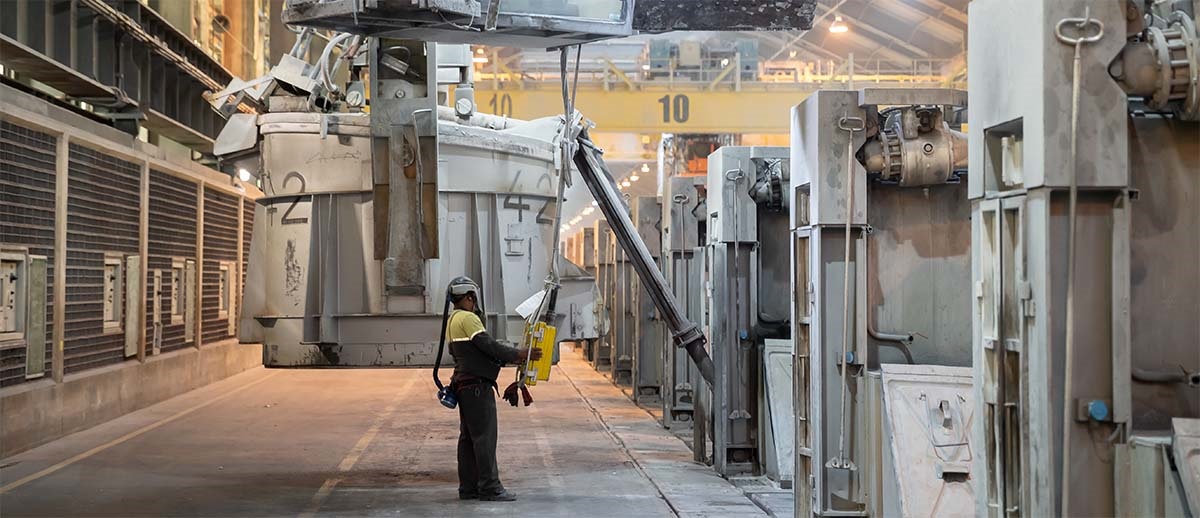
01 OCTOBER 2025
South Africa’s aluminium industry has a long-standing history, with over 70 years of semi-fabrication and 45 years of primary production. Hillside Aluminium has a vital role to play in sustaining and advancing this legacy.
Hillside Aluminium (Hillside) is an important contributor to South Africa’s economy1 and a significant employer in the province of KwaZulu-Natal, where the unemployment rate is around 30%2:
- Hillside employs over 2,500 employees and contractors and supports an estimated 29,000 indirect employment opportunities. 90% of Hillside’s employees are Black People3 and just under a third are women.
- Over the last three years, Hillside has paid US$195 million in wages and salaries, US$139 million in government payments and contributed more than US$22 million to a range of local community programs and initiatives.
Strengthening South Africa’s aluminium value chain relies on the continued modernisation of semi-fabrication capacity and access to locally produced aluminium, particularly in liquid form. Hillside is South Africa’s only producer of primary aluminium. Each year, the smelter supplies both liquid metal and solid aluminium (around a quarter of production) to domestic customers, including two organisations operating out of a neighbouring casthouse:
- Hulamin: As the largest aluminium semi-fabricator in sub-Saharan Africa, Hulamin employs over 1,500 people and generates more than half of its revenue from domestic sales. Hulamin owns and operates the casthouse, where it produces aluminium slab. Since 2013, Hillside has supported the operation of this facility by supplying competitively priced liquid metal.
- Bingelela Alloys: Led by a local Black economic empowerment group, with majority ownership held by Black women, Bingelela Alloys is South Africa’s only domestic producer of rim alloy for the automotive sector. In 2022, Hillside supported Bingelela's growth through a US$2.5 million loan from its Enterprise and Supplier Development program. In FY25, Hillside provided a further US$6 million in concessional financing to support the procurement of new furnaces, enabling the return of leased furnaces to Hulamin.
A further increase in domestic sales is anticipated, supported by potential future sales to AluSouth – a prospective market entrant aiming to revive a dormant aluminium rod facility at the casthouse. The facility is expected to produce aluminium rod for use in transmission and distribution line construction, helping to reduce reliance on higher-cost imports, contribute to Eskom’s planned grid expansion, and supporting local job creation. With an estimated establishment cost of US$20 million, funding is being sought from government and commercial partners. Hillside plans to contribute more than US$4 million in concessional financing to support the initiative.
By supplying primary aluminium to domestic manufacturers, enabling the development of semi-fabrication facilities, and supporting Black- and women-owned enterprises, Hillside is making an important contribution to South Africa’s ongoing industrial development.4
1 Economic and indirect employment information is drawn from a third-party assessment of the socio-economic contribution of Hillside Aluminium to South Africa, undertaken in FY25.
Hillside's estimated direct GDP contribution in 2024 was ZAR2.9 billion. For every ZAR1.00 increase in Hillside's local spend, it is estimated that ZAR0.43 is added to South Africa’s GDP.
2 As reported in the Quarterly Labour Force Survey by Statistics South Africa for Q2 2024, available at www.statssa.gov.za.
3 Generic term meaning Africans, Coloureds and Indians who are citizens of South Africa, defined in the Broad-Based Black Economic Empowerment Amendment Act, 2013.
4 Aluminium beneficiation refers to the process of adding value to raw aluminium or aluminium-bearing materials through local processing, manufacturing, or fabrication, rather than exporting them in raw or semi-processed form.
Topics
